Zona
Recycles dryer sheets
- Joined
- Apr 26, 2013
- Messages
- 208
I have a question on how the federal taxes will work on a Roth Conversion if we are retired and living off of only dividends (mostly qualified) and capital gains for the first few years. (We're not quite FIRE'd yet, but hope to be soon and want to understand how Roth Conversions are taxed in this situation.) I'm hoping someone who understands taxes better than I do (or who has done similar conversions) can give me some guidance.
Let's say I have three buckets: one Roth IRA (that has existed for > 5 years), one Traditional IRA, and my taxable brokerage.
So hypothetically let's say I am fully retired on Jan 1, 2020. I'll get around $18K in dividends from my taxable brokerage, of which $17K are qualified ($1K ordinary divs). I also sell stock from the taxable brokerage that results in $45K of capital gains. We have no other ordinary income for the year, and the MFJ standard deduction for 2020 is $24,800.
I have built a spreadsheet that mimics the "Tax Projection Worksheet - Tax Using Capital Gains Rates" from the 1040. (Or at least I *think* it mimics it, but I'm trying to confirm if I set it up correctly). Given the income numbers above, my spreadsheet says that I can convert $43K from my Traditional IRA to my Roth IRA and only end up paying $2,125.00 in Federal Taxes. Does this sound right?
It just seems like a very small amount to be paying in taxes to convert that much. Thanks in advance for any guidance!
Let's say I have three buckets: one Roth IRA (that has existed for > 5 years), one Traditional IRA, and my taxable brokerage.
So hypothetically let's say I am fully retired on Jan 1, 2020. I'll get around $18K in dividends from my taxable brokerage, of which $17K are qualified ($1K ordinary divs). I also sell stock from the taxable brokerage that results in $45K of capital gains. We have no other ordinary income for the year, and the MFJ standard deduction for 2020 is $24,800.
I have built a spreadsheet that mimics the "Tax Projection Worksheet - Tax Using Capital Gains Rates" from the 1040. (Or at least I *think* it mimics it, but I'm trying to confirm if I set it up correctly). Given the income numbers above, my spreadsheet says that I can convert $43K from my Traditional IRA to my Roth IRA and only end up paying $2,125.00 in Federal Taxes. Does this sound right?
It just seems like a very small amount to be paying in taxes to convert that much. Thanks in advance for any guidance!


